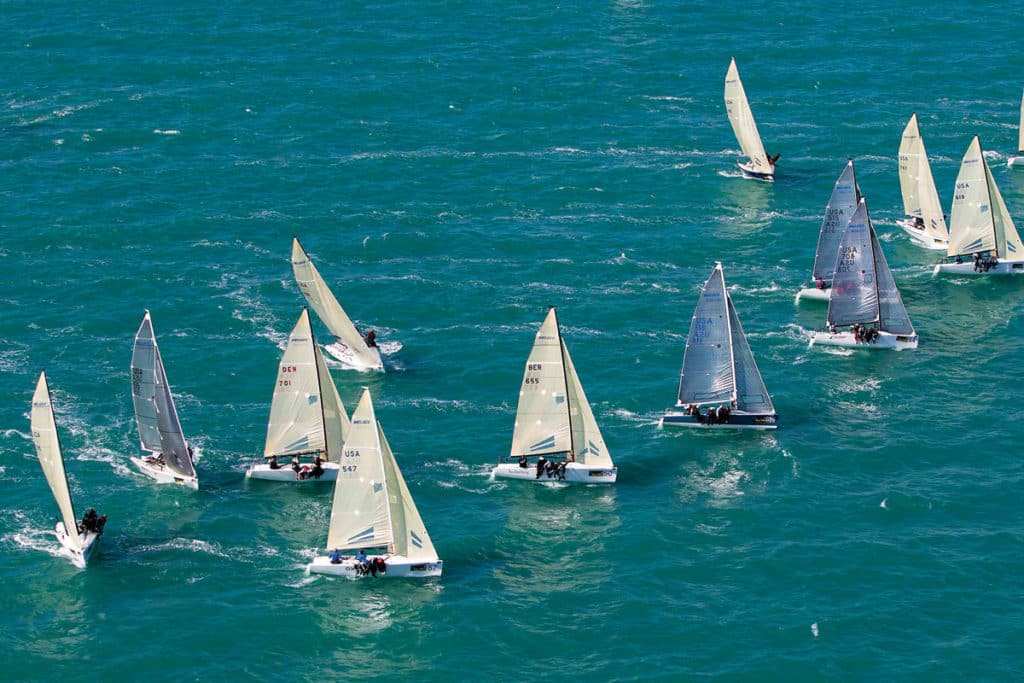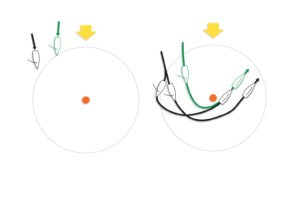Having spent more time in the middle of the fleet than I’d care to admit at a recent regatta, either due to having a bad start, picking the wrong side of the first beat, or having boatspeed that was merely average, I started thinking about how to break out from the middle of the pack. When conditions are steady, race leaders typically leg out, but the boats immediately behind tend to condense around certain areas of the racecourse. When this happens, there are passing lanes. By setting up for strong mark roundings and picking smart areas to sail clean upwind and downwind, all it takes is a few things done right to make a mid-fleet position a keeper finish.
ACCEPT AND DO THE RIGHT THING
With competitive juices flowing shortly after the start, it’s difficult to accept that an error was made, which resulted in a bad position right off the bat. The top priority should be to quickly evaluate your position in the fleet and focus on getting into a stronger position with the boats around you. Winning the race is probably not an option at this stage, so instead of giving in to the temptation to take a flyer to the corner, continue to sail in the most wind, with a clean lane to start chipping away at the distance to the lead pack.
AVOID TRAFFIC UPWIND
Boats in packs slow each other down, and only a few emerge strong, so assess your position with the boats around you. To eliminate a bad lane or clearing tack, think about where the boats ahead might tack. When possible, either lead the pack that’s crossing ahead of you to the center of the course by tacking to leeward and ahead, or hip up on the group if that’s the better option for less traffic. Thinking two to three moves ahead and putting a priority on lane management, while minimizing tacks and jibes, is crucial when you’re behind.
USE THE LEADERS AS BLOCKERS
Take advantage of the gap between you and the leaders. Their immediate dirty air will deter any boats between you and them from tacking, allowing you to sail in phase or get to the preferred side of the course quicker. Picking a lane in which to live on the upwind leg can keep you within striking distance, but having a keen eye on whether you’re losing or gaining with the boats around you will be the determining factor, whether or not you’re far enough behind the leaders to live in a lane to leeward and behind.
MANAGE THE WINDWARD MARK LAYLINE
When you’re near the top of the beat, sail to leeward of the pack of port-tack boats approaching the starboard-tack layline and tack shy of the layline for an easy gain and a strong position on the run. More often than not, most sail to the starboard-tack layline early, and their lanes get snatched quickly. They’re forced to do several clearing tacks, which ultimately results in being overstood, sailing a lot of extra distance, and going slow. Tacking 10 to 12 lengths shy of layline allows you to sail less distance, and although there may be a lot of boats ahead casting dirty air, you can typically live well enough in this area, while the boats crossing ahead of you on port tack continue to the layline and get tangled up in the fray. Again, paying attention to whether or not you are losing gauge with the boats around you is the determining factor as to whether you should stay.
There are, however, a few cautionary items with this move. It doesn’t work as well in light air, as the cone underneath the windward mark becomes tougher to live in, and this move often results in a port-tack layline approach, which can be risky. When executed well, however, the gains will set you up for a better downwind leg.
When tacking shy of port layline isn’t an option, sail a few lengths beyond the starboard layline, come in with speed, and encourage any other port-tack boats to tack to leeward and ahead. This will not only preserve your lane, but the other boats can be used as blockers. Despite sailing extra distance, overstanding by a few lengths can result in fewer tacks or less time spent in a bad lane.
AVOID TRAFFIC AND BE PATIENT ON THE RUN
At a recent Melges 20 regatta, both McKee brothers (Jonathan and Charlie) passed on opportunities to jibe on a small shift with the boats around them. When I later asked them why, they both separately responded, “Clear air.” After watching their gains with this type of patience, it became clear that the ability to sail the best VMG mode downwind was more beneficial than being tangled up with the group to get a small part of the shift. There are exceptions to every rule, but when in the middle of the fleet, be patient as you pick a clear spot to jibe and get separation, and don’t let the boats around you dictate your mode.
COME IN WITH PACE TO THE BOTTOM MARKS
Downwind laylines are always farther out than you think. When working from behind in the fleet, it’s amazing to see how much the fleet slows and condenses at the bottom mark. Just when you think you’re at layline, count to 10, and then count another 10 from there, and then you typically will be on a solid layline. When the fleet starts to approach both layline corners downwind, most tend to get itchy, jibe early, and then end up soaking low into the gates while trying to manage a clean lane. By being patient, going a bit longer than you think to layline, and sailing a slightly hotter mode to the mark, you can gain. The risk with this move is getting into traffic with boats that have rounded the mark and are headed upwind, so keep your eyes peeled.
EXIT EVERY MARK WITH PACE
When working from behind, your margin for error is much smaller, so having a good leeward-mark rounding and setting yourself up for a clean lane on the upwind leg is crucial. The bow team needs to be prepped for a good mark rounding; approaching and exiting with speed is important to battle through chop, dirty air, and traffic. Rounding the favored gate is always the goal, but choosing the gate with less traffic can often result in more speed and options when you’re exiting the mark. A sloppy, mid-fleet leeward mark rounding often leads to a bad lane or a down-speed tack in an already congested area, which will wash away any gains you’ve made. There’s typically only one bottom-mark rounding each race, so nail it.
FINISH AT THE FAVORED END
This is true regardless of where you are in the fleet, but when battling from the middle, your comeback isn’t complete until you finish ahead of the pack you’re battling with, which can often result in a five-point swing. In the latter half of the last leg, get a set of eyes on the finish line and use the boats ahead to find which end is favored, or typically more crowded. Continue to sail in clean lanes as you consider how to set up for a strong finish.
By thinking a few moves ahead, finding sneaky lanes, managing your mark roundings, and keeping the pedal down, a mid-fleet position can turn into a regatta- or series-defining race. Make it happen.










